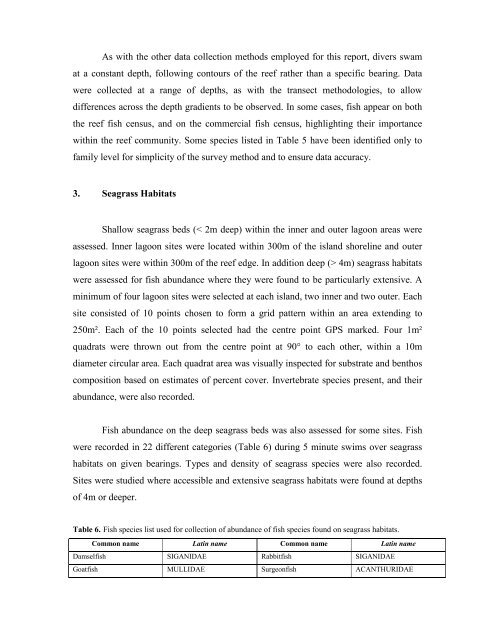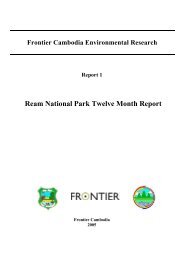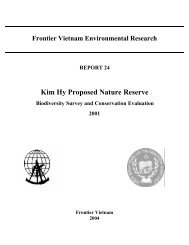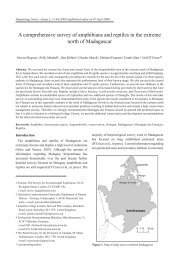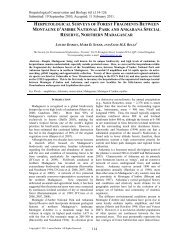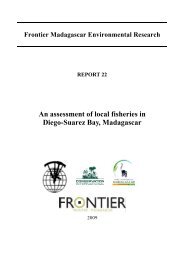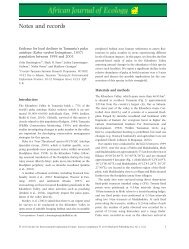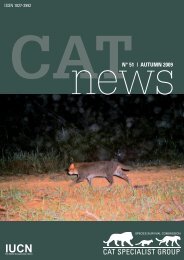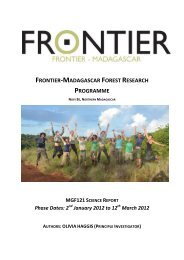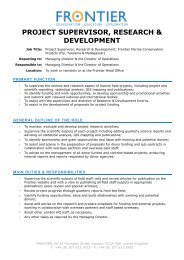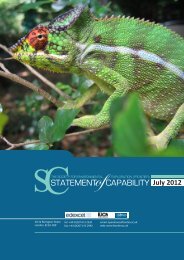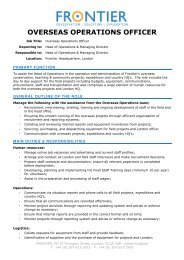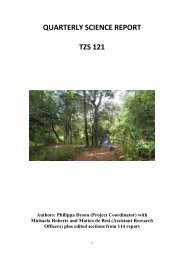Biophysical Survey of Mafia Island Marine Reserves
Biophysical Survey of Mafia Island Marine Reserves
Biophysical Survey of Mafia Island Marine Reserves
Create successful ePaper yourself
Turn your PDF publications into a flip-book with our unique Google optimized e-Paper software.
As with the other data collection methods employed for this report, divers swam<br />
at a constant depth, following contours <strong>of</strong> the reef rather than a specific bearing. Data<br />
were collected at a range <strong>of</strong> depths, as with the transect methodologies, to allow<br />
differences across the depth gradients to be observed. In some cases, fish appear on both<br />
the reef fish census, and on the commercial fish census, highlighting their importance<br />
within the reef community. Some species listed in Table 5 have been identified only to<br />
family level for simplicity <strong>of</strong> the survey method and to ensure data accuracy.<br />
3. Seagrass Habitats<br />
Shallow seagrass beds (< 2m deep) within the inner and outer lagoon areas were<br />
assessed. Inner lagoon sites were located within 300m <strong>of</strong> the island shoreline and outer<br />
lagoon sites were within 300m <strong>of</strong> the reef edge. In addition deep (> 4m) seagrass habitats<br />
were assessed for fish abundance where they were found to be particularly extensive. A<br />
minimum <strong>of</strong> four lagoon sites were selected at each island, two inner and two outer. Each<br />
site consisted <strong>of</strong> 10 points chosen to form a grid pattern within an area extending to<br />
250m². Each <strong>of</strong> the 10 points selected had the centre point GPS marked. Four 1m²<br />
quadrats were thrown out from the centre point at 90° to each other, within a 10m<br />
diameter circular area. Each quadrat area was visually inspected for substrate and benthos<br />
composition based on estimates <strong>of</strong> percent cover. Invertebrate species present, and their<br />
abundance, were also recorded.<br />
Fish abundance on the deep seagrass beds was also assessed for some sites. Fish<br />
were recorded in 22 different categories (Table 6) during 5 minute swims over seagrass<br />
habitats on given bearings. Types and density <strong>of</strong> seagrass species were also recorded.<br />
Sites were studied where accessible and extensive seagrass habitats were found at depths<br />
<strong>of</strong> 4m or deeper.<br />
Table 6. Fish species list used for collection <strong>of</strong> abundance <strong>of</strong> fish species found on seagrass habitats.<br />
Common name Latin name Common name Latin name<br />
Damselfish SIGANIDAE Rabbitfish SIGANIDAE<br />
Goatfish MULLIDAE Surgeonfish ACANTHURIDAE


